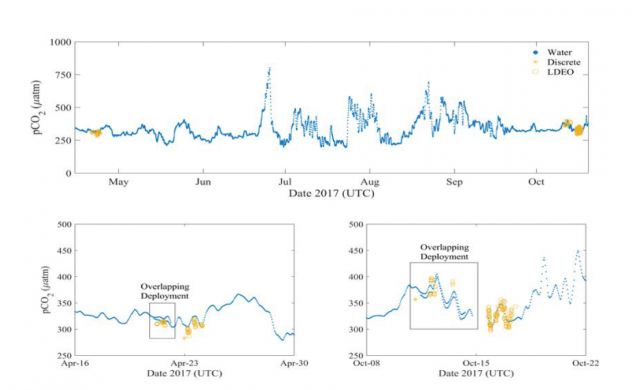Identifying Impacts of Ocean Acidification and Hypoxia
Francis Chan, Department of Integrative Biology, Oregon State University, Corvallis, OR, USA. Extracted from OOI Science Plan, 2021.
Over the past decade, ocean acidification (OA) has emerged as a leading threat to marine ecosystems, and the fisheries and shellfish growers that depend on a productive and vibrant ocean. The rapid emergence of OA has also placed new demands on our nation’s ocean observing systems. Understanding the exposure risks that different regions, habitats, and industries face not just today, but how those risks will change through time, and in relation to other environmental stressors, such as hypoxia (low oxygen) and warming, is vital to sound management and policy planning. An example of the connections between ocean observations and decision making can be seen in the US West Coast. As part of a federal-state partnership, an extensive inventory was created to catalog the location, duration, and technologies of sensors used to monitor OA and hypoxia. This inventory is being used to inform assessments of monitoring gaps across the region. Outcomes of one assessment conducted for California highlight the essential need for long-term, sustained, coupled physical-biogeochemical-biological monitoring in supporting activities ranging from pollution control, advancing end-to-end models, to development of mitigation practices, among others. At the same time, the assessment also highlights the scarcity of such crucial, sustained, and integrative observing efforts.
One notable exception is the OOI Endurance Array. This Pacific Northwest array is situated in an epicenter for early impacts from the co-occurrence of OA and hypoxia. The costs of such global change stressors are well known for both shellfish growers and the Dungeness crab fishery in grounds and feeds into shellfish farms each year. The value of the Endurance Array also lies in its synergies with other ocean observing and research activities active in the region. Parts of the Endurance Array occupy the Newport Hydrographic line where crucial multi-decadal time-series observations of zooplankton community structure are ongoing. The Array is also nested within a broader network of marine reserves, fisheries, and coastal water quality observing efforts. How best to marry and translate these varied data streams into decision-relevant knowledge is not yet clear, but such networks provide key opportunities for an observing system that serves the ocean’s varied stakeholders and offer a truly integrated system for detected and tracking ocean ecosystem changes.
Ocean ecosystems and the resources that coastal economies depend on will face unprecedented changes in carbonate chemistry, even in the near future. The changes in pH, pCO2 (Fig. 2.7) or the corrosivity of the waters to shell-bearing marine life will be accompanied by lower levels of dissolved oxygen and seawater temperatures that will manifest as episodic hypoxic zones and marine heat waves. Much remains to be learned about the trajectory of these changes, their impacts, and solutions that can be mobilized to protect ecosystems and fisheries. Will OA risks be amplified or dampened by climate change? Will our ability to anticipate ecological surprises erode as OA, hypoxia, and warming intensifies in concert? What management practices can be employed to lessen both such surprises and their impacts? As the adoption of science-informed OA Action Plans across West Coast States attests, planning for change is essential, and sustained ocean observing will play a vital role in guiding the actions we will take.

